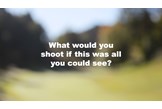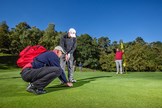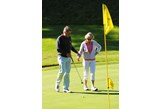Prepare to be awestruck as we explore the world of blind golf
Published: Last updated:
What’s the most impressive shot you’ve ever seen hit live, in the flesh? Until recently, I had three contenders: Joe Miller launching drives at 200 miles per hour, the ball disappearing upon impact and arcing back into view 400 yards away; Rory McIlroy hitting a 5-iron that never left the flag from 239 yards to set up a second eagle in three holes en route to his 2014 Open victory; And Phil Mickelson hammering full-swing flop shots, from tight lies, with so much loft they only narrowly avoided going up his nostril. But all three of those were blown out of the water recently when I watched Mark Sturdy hit his driver 190 yards. Mark Sturdy is blind.
“The deterioration of my sight was gradual at first,” says 44-year-old Sturdy. “I had 12 lots of surgery in eight years. I went in for an operation on my left eye, which was still quite strong – I was still driving – the idea being that the operation would stop it ever getting as bad as my right. But the surgeon pulled the retina off during the operation.

“When he told me what had happened, I said, ‘Okay, what’s next then?’ and he said, ‘Well, actually, nothing. We can’t do anything.’ It was a big shock. I sulked for a year and barely left the house.”
It was golf that offered Sturdy a fresh start. “I used to do ice hockey and skydiving,” he says, “but I couldn’t do those anymore after I lost my sight. Some friends suggested I try golf, but I thought it would be worse than watching paint dry.
“They eventually convinced me to try it and I loved it straight away. It got me back out of the house and meeting people. I play two or three times a week and my handicap has come down 10 shots this season.”
“My handicap has come down 10 shots this season”
Sturdy is one of over 100 registered blind golfers in the UK, with ages ranging from 17 to 82. Blind golf, which sees golfers play full-length courses with the aid of a caddie and guide to help them navigate the course and line up shots, has over 500 registered members across 13 countries.
“Most people think when you lose your sight you’re finished,” says 78-year-old Neil Baxter, Chairman of England and Wales Blind Golf (EWBG). “Anybody who has lost their sight will agree that it’s a very traumatic experience, but golf can play a huge role in the rehabilitation process. Golf is one of the greatest ways to get people back into the swing of life and hand them back their self-confidence and self-respect.”
Blind golf is governed by the R&A, the only rule changes being that blind golfers are allowed to ground their club in a bunker and the guide is allowed to stay on the line of putts to help them aim on the green.

Handicap limits vary depending on the level of sight. B1 players, with no sight whatsoever, have a maximum handicap of 54, while those with severely-impaired sight are limited to 45, and players with less severe conditions are limited to 36.
“My vision is about seven per cent of normal,” says 50-year-old Simon Cookson, registered as a B3. “I can’t see very much. I can see where the sky turns to trees, but that’s about it.”
“I can see where the sky turns to trees, but that’s about it”
Cookson was a keen and talented golfer, representing his county before his eyesight deteriorated.
“Once my sight went and I stopped seeing the ball in flight, I lost the buzz for it. It just wasn’t the same when I couldn’t visualise the shot and then see the result. I didn’t pick up a club for about 10 years.”

When he did set foot back on the course, Cookson discovered that he hadn’t lost any of his golfing prowess. “My local pub were invited on a golf day but didn’t have enough players, so they asked me to help out. My dad still had an old set of clubs in the house so I gave it a go. I shot 75 around Tidworth Garrison and it made me realise I could still do it. It’s been full-on since then. I’ve played in a lot of the international tournaments. I’ve won the Canadian Open, the World Championships twice, and the British Masters.”
Cookson had the advantage of being an accomplished golfer before losing his sight, but Baxter insists that it is possible to learn the game without being able to see your swing. “We provide training sessions for newer golfers,” says Baxter, born with a serious eye condition which worsened to leave him with below 10 per cent visibility.
“As you can imagine, learning to play golf as a blind person is incredibly difficult. It’s alright for people like myself who played when I had reasonable vision – you get your swing before you lose your sight – but try to explain the golf swing to a totally blind person and they think you’re talking Double Dutch.”
“Trying to learn the golf swing as a blind person is incredibly difficult”
Sturdy proves that although it is tough, it is doable. “I went to a normal pro at my local club,” he says. “It was a bit of a learning curve for both of us, because he’d never done anything with a blind person before, but we made it work.
“I started in the month of January and by April I was taking on sighted players.”
Figures published by the Royal National Institute of Blind People (RNIB) show that almost two million people in the UK are living with sight loss, equating to approximately one in 30. Baxter believes that more of them could benefit from golf, if the largest barrier to entry is overcome.
“The problem is that not enough people know about us, and we don’t have enough people to serve as caddies,” he says.
“There are blind people who want to play but can’t because they don’t have a guide.
“Blind golf is a two-person sport”
“Blind golf is a two-person sport. Players can’t play the game without a caddie. The biggest thing that anybody can do for us would be to become a guide. That would enable more players to play.”

Whether you can help out on one day of the EBGA calendar – there are tournaments across the country each year – or on a more regular basis, we would urge you to consider getting involved. It can be a rewarding experience for all concerned. “I can honestly say that playing 18 holes with a blind golfer is one of the most stimulating and life-affirming experiences that you can have as a sportsman,” says the BBC’s John Inverdale.





